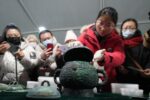 Archaeologists have unearthed a bronze lidded vessel in a tomb from the Western Zhou Dynasty (1,046 – 771 B.C.) on the outskirts of Beijing that is believed to be the pair of one found at the site in the 1970s.
Archaeologists have unearthed a bronze lidded vessel in a tomb from the Western Zhou Dynasty (1,046 – 771 B.C.) on the outskirts of Beijing that is believed to be the pair of one found at the site in the 1970s.
The bronze vessel is of the gui type, a wide-mouthed food container with a ringed base. inscriptions on the pot match ones found on a bronze vessel 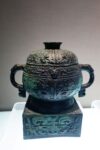 unearthed from a tomb at Liulihe site in 1974, except they’re flipped. The inscription in the lid of the newly-discovered pot is the same as the inscription on the bottom of the pot found in the 1970s. Archaeologists believe they were a matched set made by a single artisan who then mistakenly put the wrong lids on the vessels.
unearthed from a tomb at Liulihe site in 1974, except they’re flipped. The inscription in the lid of the newly-discovered pot is the same as the inscription on the bottom of the pot found in the 1970s. Archaeologists believe they were a matched set made by a single artisan who then mistakenly put the wrong lids on the vessels.
The character “yong,” which refers to the establishment of a city, was found within the inscription, explained Sun Qingwei, a professor at Peking University, direct evidence that one of the ranking officials of the king of the Western Zhou Dynasty had established a city in what is now Liulihe town more than 3,000 years ago.
Bronze vessels served an important ritual purpose for funerary offerings of 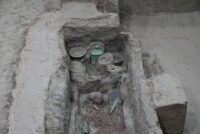 food and drink and as household goods for the deceased in the afterlife, but in the Western Zhou the practice took on an added significance as status symbols. Only the elite were allowed to own bronzes. Later chroniclers record that the number of bronze “ding” (footed food cauldrons) allowed in graves was strictly apportioned according to noble rank in the Western Zhou, the emperor could have nine, lords could have seven, ministers five, etc.
food and drink and as household goods for the deceased in the afterlife, but in the Western Zhou the practice took on an added significance as status symbols. Only the elite were allowed to own bronzes. Later chroniclers record that the number of bronze “ding” (footed food cauldrons) allowed in graves was strictly apportioned according to noble rank in the Western Zhou, the emperor could have nine, lords could have seven, ministers five, etc.
Excavations at the site in the 1970s were disturbed by high ground water 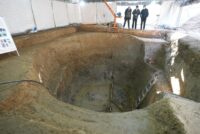 levels. New technology has developed since then to gradually drain and excavate archaeological remains in a way that preserves even delicate organic materials. The team excavated the tombs from outside of the burial chamber inwards. By working this way, they discovered overlapping layers of lacquerware and textiles. Archaeologists also discovered the first wooden arrow shafts from the Western Zhou Dynasty ever found in Beijing, and in another first for Beijing, were able to successfully recover silk patterned fabric from the early Western Zhou Dynasty.
levels. New technology has developed since then to gradually drain and excavate archaeological remains in a way that preserves even delicate organic materials. The team excavated the tombs from outside of the burial chamber inwards. By working this way, they discovered overlapping layers of lacquerware and textiles. Archaeologists also discovered the first wooden arrow shafts from the Western Zhou Dynasty ever found in Beijing, and in another first for Beijing, were able to successfully recover silk patterned fabric from the early Western Zhou Dynasty.
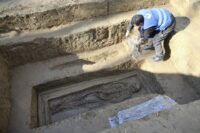 Tomb M1902 was absolutely packed with precious offerings: copper lifting beams, bronze statues, bronze tripods, bronze swords, pottery, lacquerware, silks. Both the coffin and its occupants’ bones are preserved in good condition. On top of the coffin is the skeleton of a dog and a copper bell. It is complete and has never been looted or reused, which is extremely rare.
Tomb M1902 was absolutely packed with precious offerings: copper lifting beams, bronze statues, bronze tripods, bronze swords, pottery, lacquerware, silks. Both the coffin and its occupants’ bones are preserved in good condition. On top of the coffin is the skeleton of a dog and a copper bell. It is complete and has never been looted or reused, which is extremely rare.
Tomb M1901 has not been fully excavated yet while the site is gradually drained, but archaeologists can see it was a very rich burial as well, containing a complete set of cart and horses.
The Liulihe residential district in southwestern Beijing contains the earliest remains of the urban settlement that would become Beijing. The tombs rich with artifacts found in Liulihe excavations over the past 50 years have shown that Bronze Age Beijing was the capital of the Yan vassal state of the Western Zhou Dynasty.
“The ongoing excavation will offer much crucial information on studies of the ritual and feudal systems of the Western Zhou period,” Chen Mingjie, director of the Beijing Municipal Cultural Heritage Administration, said. “It is also a key to see how early-stage cities were planned in China.”
Four rammed earth architectural foundations and seven large water wells have also been excavated in Liulihe this year, indicating that full use of ground water was considered by the city’s planners.
“The new findings in Liulihe will further portray a panorama of the Yan vassal state, which was a historical foundation of the Beijing-Tianjin-Hebei coordinated development today,” Shan Jixiang, head of the Chinese Society of Cultural Relics, said. “It will also demonstrate how diverse cultures mixed with each other and formed a united Chinese civilization.”
Seriously doubt that the artisan would have mixed up the lids. More likely the matched set was displayed for many years and the lids were switched during that time.